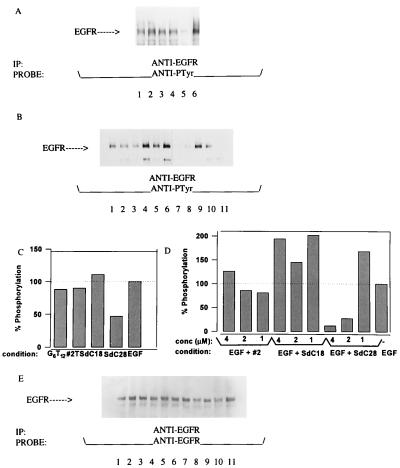Figure 2.
(A) Effect of phosphorothioate oligodeoxynucleotides on EGFR activity in KB cells. Shown is oligodeoxynucleotide-induced phosphorylation of EGFR immunoprecipitated from lysates of KB cells following a 10-min incubation at room temperature with 2 μM of the oligodeoxynucleotides G6T12 (lane 1), #2T (lane 2), SdC18 (lane 3), SdC28 (lane 4), or without oligodeoxynucleotide in the absence (lane 5) and presence (lane 6) of EGF. (B) Effect of oligodeoxynucleotides on EGF-induced activation of EGFR. The level of receptor phosphorylation is shown for EGF (10 ng/ml)-stimulated cells preincubated with 4 μM, 2 μM, and 1 μM of the oligodeoxynucleotides #2 (lanes 1–3), SdC18 (lanes 4–6), SdC28 (lanes 7–9) versus EGF-stimulated cells (lane 10) and unstimulated cells (lane 11). (C and D) Densitometry scans of the EGFR phosphorylation shown in A and B, respectively, plotted with the unstimulated control measurements subtracted. (E) Blots from B reprobed with an anti-EGFR polyclonal antibody showing the same level of receptor per lane.

